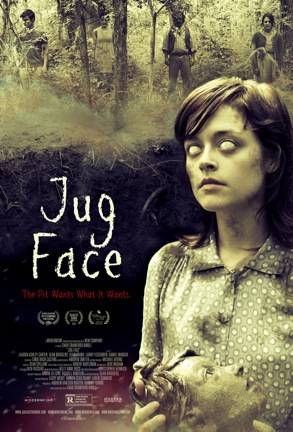Studio: Gravitas Ventures
Director: Chad Crawford Kinkle
Writer: Chad Crawford Kinkle
Producer: Robert Tonino, Andrew van den Houten
Stars: Lauren Ashley Carter, Sean Bridgers, Sean Young, Larry Fessenden, Daniel Manche
Review Score:
Summary:
A teenage girl questions her backwoods community’s religious-like devotion to a mysterious pit in the woods.
NOTE: "Jug Face" was released as "The Pit" in the UK.
Review:
“Jug Face” is a spiritual companion to Lucky McKee’s “The Woman.” Although not as controversially dark, “Jug Face” still blends uncomfortable taboos into its tale of backwoods country folk whose lives involve a religious-like reverence of a mysterious pit in the woods. With McKee also onboard “Jug Face” as an executive producer, both films share two of their leads, Lauren Ashley Carter and Sean Bridgers, in addition to their similarly unsettling tones.
Not too much can be shared about the plot details. Not because the story involves any Keyser Soze-like twist, but because it unfolds in a very calculated order. Director Chad Crawford Kinkle wants to expose the audience to “Jug Face” in a deliberate manner, and that carefully chosen sequencing works brilliantly. Scenes take on different meanings later in the film as new character relationships are identified and as additional backstories are exposed. The story is easily followed, but the piecemeal revelation creates a layered viewing experience without relying on storytelling shocks or having to keep secrets from the audience.
“Jug Face” is about a backwoods community that keeps to themselves and their secluded way of life. These are the kind of country folk who do their laundry on a washboard in the crick and who celebrate major events with music that features clanging spoons as an instrument. Their names include Bodey, Jessaby, Sustin, and Loriss. They drink moonshine and use words such as “joining” in reference to marriage and “dripping” with regards to menstruation. But these are not inbred hillbillies likely to play dueling banjos anytime soon. Their faith in “The Pit” is rooted in proven miracles, and not in religious fear of a supernatural creature. Although the healing gifts of the pit do come with a price, as the sentient hole in the forest floor gives only as much as it takes away.
By keeping details of character motives and the pit mythology from spilling completely on the table upfront, “Jug Face” makes way for a mood that is free to creep at its own revelatory pace. The slow crawl stride of the film goes unnoticed, with interest sustained by the developing personalities. As simple as their ways are, they are also fascinating. There is much more going on in this place than just a dimwit tribe of bumpkins blindly worshipping a hole in the ground.
Whatever country stereotypes still existed in the script when filming began were shed by performances that treat the roles as reverentially as the characters treat the pit. The cast respects these personalities as having complexities that belie their rustic way of life. Sean Bridgers turns disposable dialogue into memorable moments with subtle inflections and subtler mannerisms. Lauren Ashley Carter gives her character Ada as much intelligence as she does internal conflict. And Larry Fessenden and Sean Young make for a pair of parents that perfectly encapsulates everything good and bad that can be attributed to the people residing in these shacks and trailers.
Adding to the film’s own personality are several unique flourishes. “Jug Face” primes the pump perfectly with an opening sequence of two-dimensional chalk-drawing animations. The style is fantastic and rewards careful attention with the complete history of the pit. (Although it may not make complete sense on the first viewing.) Andrew Smetek is rightly credited for Sound Design rather than for Music or as a composer. The distorted electric guitar strains seemed out of place with the setting at first. But the score quickly fades into being the pulse beat of the film and ties each scene together into a free flowing stream.
The horror in “Jug Face” is illustrated by how these families treat one another. Whatever is in the pit is just a physical manifestation of the psychological terror that permeates the community. Any time that a more internally fueled horror movie features a physical creature as a distraction, there may be those in the audience who become bored by a perceived lacking of action and constant movement in the surrounding scenes. Through no fault of their own other than personal tastes in cinematic style, not everyone will be able to see how “Jug Face” works. The movie’s aim is to frighten through the mind and not through the eyes. The method will not work on everyone, but those whose patience allows them to be drawn into the setting will find “Jug Face” to be both thoughtful and chilling.
Review Score: 80






It assumes everyone watching must be a dimwit too dense to understand how the most basic storytelling concepts work.